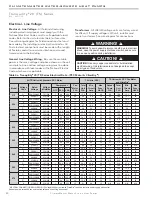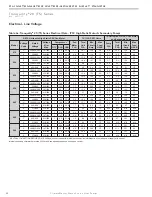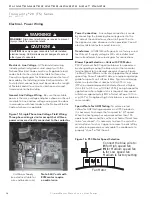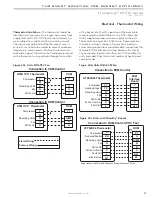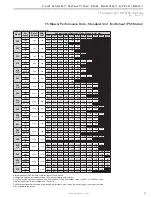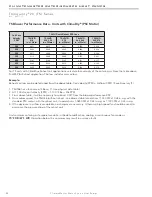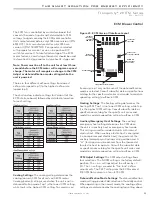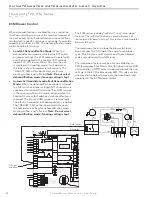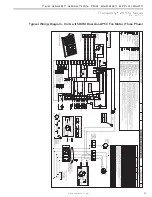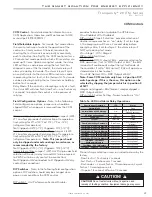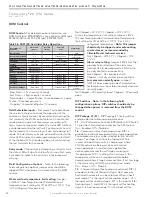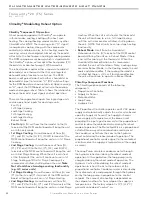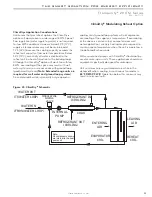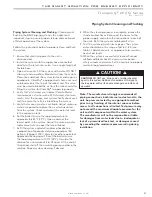
33
c l i m a t e m a s t e r. c o m
T H E S M A R T S O L U T I O N F O R E N E R G Y E F F I C I E N C Y
Tr a n q u i l i t y
®
2 0 ( T S ) S e r i e s
R e v. : 0 6 / 1 7 / 1 5
ECM Blower Control
The ECM fan is controlled by an interface board that
converts thermostat inputs and fi eld selectable CFM
settings to signals used by the ECM motor controller.
Units manufactured before July 2005 have version I (P/N
69243707). Units manufactured after July 2005 have
version II (P/N 17B0019N01). Fan speeds are selected
with jumpers for version I or via a nine position DIP
switch for version II. To take full advantage of the ECM
motor features, a multi-stage thermostat should be used
(2-stage heat/2-stage cool or 3-stage heat/2-stage cool).
Note: Power must be off to the unit for at least three
seconds before the ECM motor will recognize a speed
change. The motor will recognize a change in the CFM
Adjust or dehumidifi cation mode settings while the
unit is powered.
There are four different airfl ow settings from lowest
airfl ow rate (speed tap 1) to the highest airfl ow rate
(speed tap 4).
The charts below indicate settings for Version II of the
ECM interface board, followed by detailed information
for each setting.
Cooling Settings:
The cooling setting determines the
cooling (normal) CFM for all units with ECM motor.
Cooling (normal) setting is used when the unit is not in
dehumidifi cation mode. Tap 1 is the lowest CFM setting,
while tap 4 is the highest CFM setting. To avoid air coil
freeze-up, tap 1 may not be used if the dehumidifi cation
mode is selected. Consult submittal data or specifi cations
catalog for the specifi c unit series and model to correlate
speed tap setting to airfl ow in CFM.
Heating Settings:
The heating setting determines the
heating CFM. Tap 1 is the lowest CFM setting, while tap
4 is the highest CFM setting. Consult submittal data or
specifi cations catalog for the specifi c unit series and
model to correlate speed tap setting to airfl ow in CFM.
Auxiliary/Emergency Heat Settings:
The auxiliary/
emergency heat setting determines the CFM when
the unit is in auxiliary heat or emergency heat mode.
This setting is used for residential units with internal
electric heat. When auxiliary electric heat is energized
(i.e. compressor and electric heat), the greater of the
auxiliary/emergency or heating setting will be used. A
“G” (fan) signal must be present from the thermostat
for electric heat to operate. Consult the submittal data
or specifi cations catalog for the specifi c unit series and
model to correlate speed tap setting to airfl ow in CFM.
CFM Adjust Settings:
The CFM adjust setting allows
four selections. The NORM setting is the factory default
position. The + or – settings adjust the airfl ow by +/-
5%. The +/- settings are used to “fi ne tune” airfl ow
adjustments. The TEST setting runs the ECM motor at
400 CFM/ton, example 2-ton = 800 CFM.
Dehumidifi cation Mode Settings:
The dehumidifi cation
mode setting provides fi eld selection of humidity control.
When operating in the normal mode, the cooling airfl ow
settings are determined by the cooling tap setting above.
Y
G
G
G
G
R
W
O
Y2
Y1
G
R
C
Y2
Y1
G
O
W
C
R
DH
AL1
A
A
AL1
SW1
SW2
SW3
SW4
SW5
SW6
SW7
SW8
SW9
OFF
ON
G
DEHUM
CFM
TB1
J1
S1
Thermostat
Input LEDs
CFM Counter
1 flash per 100 CFM
ECM Motor
Low Voltage
Connector
1/4" Spade
Connections
to CXM or
DXM Board
Thermostat
Connections
Dehumidification
LED
Fan Speed Selection DIP Switch
Figure 23: ECM Version II Interface Layout


